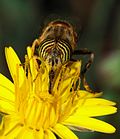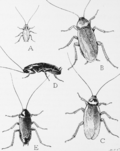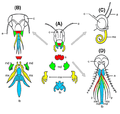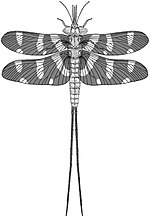modes of feeding. The earliest insects had chewing mouthparts. Most specialisation of mouthparts are for piercing and sucking, and this mode of feeding...
16 KB (1,834 words) - 01:23, 11 August 2024
and move vertically. The mouthparts of orthopteran insects are often used as a basic example of mandibulate (chewing) mouthparts, and the mandibles themselves...
7 KB (862 words) - 17:34, 25 April 2024
and mouthparts located outside of the head capsule. This position of the mouthparts divides them from their closest relatives, the non-insect hexapods...
129 KB (17,131 words) - 21:20, 8 August 2024
The mouthparts of arthropods have evolved into a number of forms, each adapted to a different style or mode of feeding. Most mouthparts represent modified...
9 KB (1,088 words) - 07:03, 22 May 2024
of mouthparts are among the most common in insects, which are used for biting and grinding solid foods. Piercing-sucking: These forms of mouthparts have...
7 KB (750 words) - 15:33, 21 May 2024
Convergent evolution (section Insect mouthparts)
flight and feeding patterns. Insect mouthparts show many examples of convergent evolution. The mouthparts of different insect groups consist of a set of...
57 KB (5,739 words) - 13:49, 18 August 2024
Mouthparts may refer to: The parts of a mouth Arthropod mouthparts Insect mouthparts This disambiguation page lists articles associated with the title...
140 bytes (44 words) - 12:39, 29 December 2019
via receptors, usually on the antennae and the mouthparts. Nearly all insects hatch from eggs. Insect growth is constrained by the inelastic exoskeleton...
134 KB (12,781 words) - 16:07, 6 August 2024
Many different species of insects have mouthparts derived from the same embryonic structures, indicating that the mouthparts are modifications of a common...
245 KB (27,658 words) - 23:47, 22 August 2024
Micropterigidae, have mouth parts of the chewing kind. The study of insect mouthparts was helpful for the understanding of the functional mechanism of the...
10 KB (996 words) - 20:15, 18 July 2024
Mosquito (redirect from Nipper (insect))
mosquito mouthparts, with grasshopper mouthparts (shown both in situ and separately) representing a more primitive condition. All the mouthparts except...
91 KB (9,100 words) - 06:30, 19 August 2024
Eusociality (redirect from Eusocial insect)
than sexually mature reproductives. One difference is that a soldier's mouthparts (pharynx) is five times as big as those of the reproductives. They make...
67 KB (7,475 words) - 18:58, 15 August 2024
Rhyniognatha (category Prehistoric insect genera)
as the oldest insect known, as well as possibly being a flying insect. Rhyniognatha is known from a partial head with preserved mouthparts from the Early...
5 KB (421 words) - 12:38, 19 June 2024
Cockroach (redirect from Roach (insect))
generalized insects lacking special adaptations (such as the sucking mouthparts of aphids and other true bugs); they have chewing mouthparts and are probably...
79 KB (8,375 words) - 15:34, 19 August 2024
Mandible (arthropod mouthpart), one of several mouthparts in arthropods Mandible (insect mouthpart), one of several mouthparts in insects Human mandible,...
650 bytes (106 words) - 17:53, 24 March 2024
Phasmatodea (redirect from Stick insect)
as Phasmida or Phasmatoptera) are an order of insects whose members are variously known as stick insects, stick-bugs, walkingsticks, stick animals, or...
52 KB (5,967 words) - 14:45, 11 August 2024
Fly (redirect from Fly (Insect))
bears the eyes, the antennae, and the mouthparts (the labrum, labium, mandible, and maxilla make up the mouthparts). The second tagma, the thorax, bears...
87 KB (9,478 words) - 00:46, 7 July 2024
Tabanidae (category Insects in culture)
horse-flies feed on nectar and plant exudates; males have weak mouthparts, but females have mouthparts strong enough to bite large animals. This is for the purpose...
44 KB (5,152 words) - 21:21, 4 July 2024
Larva (redirect from Insect larvae)
lepidopterans. Oligopod larvae – have well developed head capsule and mouthparts are similar to the adult, but without compound eyes. They have six legs...
15 KB (1,347 words) - 12:16, 6 August 2024
segments with compound eyes, ocelli, antennae and mouthparts, which differ according to the insect's particular diet, e.g. grinding, sucking, lapping and...
35 KB (4,441 words) - 02:16, 5 July 2024
the labrum derives from paired appendages. Arthropod head problem Insect mouthparts Haas, M. S.; Brown, S. J.; Beeman, R. W. (2001). "Pondering the Procephalon:...
6 KB (703 words) - 15:00, 2 August 2024
reveal the form and functional mechanism of insect mouthparts relationships. The study of insect mouthparts was helpful for the understanding of the functional...
7 KB (778 words) - 22:22, 3 July 2024
sometimes wings, and resemble small flies. Scale insects are herbivores, piercing plant tissues with their mouthparts and remaining in one place, feeding on sap...
46 KB (4,747 words) - 07:20, 30 July 2024
Plant virus (section By insects)
in insect-mediated viral transmission. The helper component will bind to the specific domain of the coat protein, and then the insect mouthparts – creating...
36 KB (4,299 words) - 15:02, 7 August 2024
Jurassic (section Insects and arachnids)
increasing diversity of insects in the Middle–Late Jurassic corresponds with a substantial increase in the diversity of insect mouthparts. The Middle to Late...
230 KB (24,882 words) - 03:17, 21 August 2024
Neuroptera (redirect from Net-winged insect)
soft-bodied insects with relatively few specialized features. They have large lateral compound eyes, and may or may not also have ocelli. Their mouthparts have...
23 KB (1,973 words) - 20:10, 20 August 2024
Bacillus rossius (redirect from European stick insect)
rossius) Eating a leaf of Rubus ulmifolius (mouthparts also visible) Adult and nymph Female stick insect Female (head's detail) A stick bug Bacillus atticus...
5 KB (327 words) - 16:37, 26 October 2023
Palaeodictyoptera (redirect from Six-winged insect)
Palaeozoic paleopterous insects. They are informative about the evolution of wings in insects. They were characterized by beak-like mouthparts, used to pierce...
5 KB (473 words) - 12:56, 31 January 2024
Gall (section Physiology of insect-induced galls)
primary categories of galls: closed and open. Insects such as wasps, moths, and flies, possessing chewing mouthparts during their adult or larval stages, typically...
43 KB (4,952 words) - 04:16, 29 July 2024
Zoraptera (redirect from Angel insect)
in appearance. They belong to the hemimetabolous insects. They possess mandibulated biting mouthparts, short cerci (usually 1 segment only), and short...
23 KB (2,137 words) - 22:52, 4 July 2024























